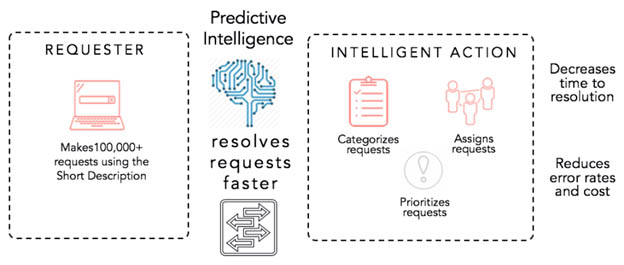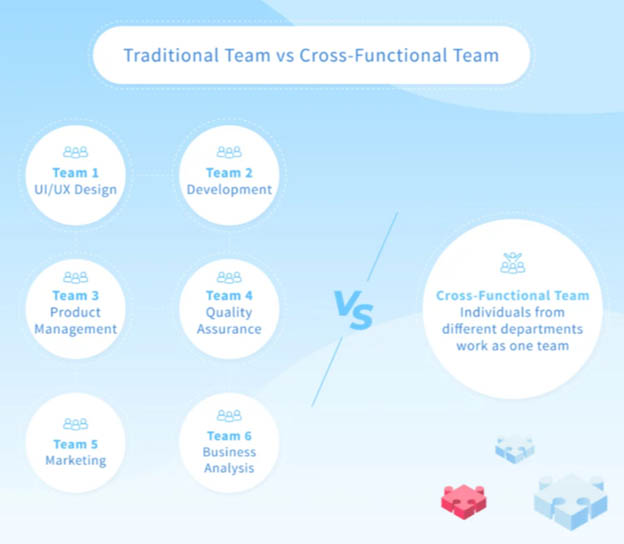ServiceNow for Successful Predictive Intelligence
Let us look at the Dos and don’ts for successful predictive intelligence.

Image Source – https://alps.devoteam.com/
Do: Understand Your Business Goals and Use Cases
The first critical step is to precisely define the exact business objectives and use cases in which predictive intelligence may add meaningful value. Have a clear vision before implementing it.
Some common use cases include:
- IT Operations: Predicting service outages, detecting infrastructure anomalies, and prioritizing incidents
- Human Resources: Identifying employee attrition risks, optimizing talent acquisition, forecasting headcount
- Customer Service: Predicting churn, automating sentiment analysis, improving case routing
- Supply Chain: Forecasting demand, optimizing inventory, scheduling maintenance
Once you’ve identified target use cases, articulate the advantages of leveraging ServiceNow predictive intelligence to address those challenges.
For example, more proactive operations, higher customer satisfaction, cost optimization, and competitive differentiation.
Work with cross-functional teams to map out current pain points, inefficiencies, and areas where data-driven predictive insights could transform processes.
Thoroughly document anticipated benefits, ROI projections, and key performance indicators to track success.
Organizations must carefully assess the disadvantages of ServiceNow predictive intelligence to determine if it aligns with their business goals and requirements.
Do: Ensure Data Quality and Availability
Work closely with subject matter experts to inventory available data sources and understand what each data set represents in a business context.
Use ServiceNow’s data preparation tools to assess and improve data quality:
- Handle missing/null values through interpolation or removal
- Identify and correct inconsistent formats across sources
- Remove duplicate records and outlier data points
- Normalize numerical data for training
Enriching data by combining complementary sources is often key. For example, merging customer demographics with product usage data for churn prediction.
With trustworthy data pipelines established, you can fully leverage the advantages of ServiceNow predictive intelligence and its data integration capabilities to build accurate, high-performing models.
Do: Collaborate with Cross-Functional Teams

Implementing predictive intelligence is very much a team sport – you’ll need collaboration across multiple roles and skill sets.
This cross-functional collaboration is in itself one of the major advantages of ServiceNow’s unified platform.
Key team members include:
- Data Scientists/Analysts to prepare data, evaluate models, and ensure business context
- Subject Matter Experts from target use case domains like IT, HR, customer service, etc.
- Data Engineers structure optimal data pipelines and flows
- Developers focused on configuring predictive intelligence within ServiceNow Consulting Services
- DevOps for CI/CD, testing, monitoring, and model updates in production
Establish a clear governance operating model defining roles, responsibilities, processes, and approval workflows.
For example, analysts may own data curation while developers own model implementation.
Leverage ServiceNow’s collaboration capabilities like shared workspaces, notifications, approvals, and dashboards.
This transparency enables teams to seamlessly coordinate on data, modeling, validation, and deployment tasks.
ServiceNow predictive analytics best practices emphasize the importance of ongoing model monitoring and refinement.
Do: Leverage AutoML and Ensemble Techniques
One powerful advantage of ServiceNow’s predictive intelligence capabilities is its automated machine learning (AutoML) and ensemble modeling functionality.
These can accelerate development cycles and boost predictive power.
AutoML
Traditional machine learning requires manually selecting the right algorithms, feature engineering, hyper-parameter tuning, and numerous other tasks.
This process is complex, time-consuming, and requires deep data science expertise.
ServiceNow’s AutoML automates much of this process through smart automation:
- Automatically evaluates various families of machine learning algorithms in parallel
- Performs intelligent feature selection and creation
- Runs Bayesian optimization to tune thousands of hyper-parameter combinations
- Stacks and blends multiple model types to create optimized ensembles
This accelerates delivery timelines and frees up data science resources to focus on other high-value activities like data acquisition and model monitoring.
Less technical users can also leverage AutoML’s functionality.
Understanding the disadvantages of ServiceNow predictive intelligence is crucial for making informed decisions about its adoption and utilization.
Ensemble Modelling
Ensemble modeling refers to combining multiple models into an optimized “model of models” that outperforms any individual technique. ServiceNow Development Services advanced methods like:
- Boosting: Sequentially training a series of models where each compensates for its predecessor’s errors
- Bagging: Creating diverse sets of models by training on different random subsets of data
- Stacking: Using one model’s outputs as inputs to a higher-level model for maximized predictive power
- Ensembles leverage the “wisdom of the crowd” by reinforcing areas where constituent models converge while smoothing out individual biases and errors in areas of divergence.
When implementing ServiceNow predictive analytics best practices, always prioritize data quality and accuracy.
READ – ServiceNow Xplore Unleashed: Transforming Development and Testing
Do: Implement Responsible AI Practices

With predictive models increasingly driving business decisions and processes, it’s critical to prioritize ethical, transparent, and responsible AI practices.
This mitigates risks around bias, privacy violations, lack of explainability, and unintended negative impacts.
Some key advantages of ServiceNow’s predictive intelligence capabilities regarding responsible AI:
- Robust data governance controls to manage access, masking, and auditing
- Tools to evaluate models for bias across demographics and subgroups
- Interpretability reports explaining how predictive models arrive at outputs
- Ability to enforce prediction thresholds and human-in-the-loop controls
Work closely with compliance, risk, and ethics teams to implement guidelines aligned with your organizational AI principles. Areas to focus on include the ethics of generative AI, ensuring responsible development, data privacy, fairness, and transparency.
- Data privacy safeguards per regulations like GDPR
- Processes for identifying and mitigating model bias
- Ensured human oversight for high-stakes predictive decisions
Staying compliant with evolving regulatory frameworks, such as the FCC consent rules, is also essential when handling sensitive data in predictive AI systems. Proactively managing responsible AI practices helps build stakeholder trust and adoption of predictive intelligence. Don’t overlook this crucial aspect.
ServiceNow predictive intelligence implementation tips can greatly enhance the effectiveness of your predictive models.
Don’t: Neglect Data Governance and Security
One key disadvantage of ServiceNow predictive intelligence, if not handled properly, is risks around data governance and security.
Machine learning models get trained on large swaths of data, often containing sensitive information.
Failure to implement strong data governance poses risks like:
- Unauthorized access to confidential data sets used for model training
- Lack of visibility into how data is being used across models
- Potential privacy violations if personal data is not properly masked
- Inability to audit data flows for compliance
Similarly, lax data security practices open the door to breaches, fraud, and misuse of data and models.
To avoid these pitfalls, establish robust data governance from the start:
- Implement robust access controls and authentication/authorization protocols
- Classify data sets and mask/anonymize personal or sensitive records
- Maintain comprehensive audit trails across all data flows and model usage
- Automate data retention and archiving policies
Don’t let data vulnerabilities undermine the advantages of ServiceNow predictive intelligence. Prioritize data governance as a core requirement.
Don’t: Overlook Model Monitoring and Maintenance

The most common disadvantage of ServiceNow predictive intelligence initiatives is model decay – where the accuracy and relevance of predictive models gradually degrade over time.
This drift occurs as real-world data patterns shift due to changing business conditions, environments, and customer behaviors.
If not monitored and addressed, this model decay can completely undermine predictive intelligence advantages like improved efficiency and proactive decision-making.
Unreliable predictions may even start causing more harm than good.
Key tips for successful ServiceNow predictive modeling
- Dashboards to continuously track model accuracy, throughput, and drift metrics
- Automated alerts when performance falls below defined thresholds
- Integration with data sources and annotation tools for retraining
- Version control and model archiving for rollback if needed
- What-if analysis to test model updates before deploying
Allocate resources for regular data refreshes and model retraining as needed.
Don’t: Attempt Deployment without Proper Testing
Whether refreshing existing models or deploying new ones, thorough testing is crucial before pushing predictive intelligence into production workflows.
Skipping this step can lead to inaccurate predictions, application errors, and security risks – disadvantages that negate all the hard work on model development.
ServiceNow provides several capabilities to streamline and automate predictive model testing:
Key tips for successful ServiceNow predictive modeling
- Spin up cloned staging environments for isolated testing
- Data anonymization tools to create secure test data sets
- Integration with CI/CD pipelines to automatically build tests
- Performance testing with simulated production load tests
- Version control and rollback in case issues arise in production
Beyond just functional tests, rigorously evaluate model accuracy using real-world test data.
Carefully inspect edge cases, boundary conditions, and distributional divergences that may reveal flawed logic.
Don’t shortcut testing and risk undermining the advantages of ServiceNow predictive intelligence.
Implement robust testing processes to ensure reliable, accurate predictions in live operations.
Don’t: Underestimate Compute & Infrastructure Needs

While the AutoML and ensemble modeling capabilities highlighted above provide immense advantages, one potential disadvantage to be aware of is the significant computing power and infrastructure resources required to run them effectively.
Machine learning in general, especially sophisticated neural networks and tree-based algorithms, is extremely compute-intensive.
The more data points, the higher the dimensionality, and the deeper/broader the models, the more processing power is needed.
AutoML compounds this by simultaneously training, tuning, and evaluating exponentially more models than traditional approaches.
Ensembling also leads to multiplicative impacts on resource requirements.
For example, a simple binary classification task might only require training and evaluating a few dozen candidate models pulling gigabytes of data from a disk.
Operationalizing these predictive intelligence workloads at scale requires carefully planning and optimizing infrastructure to meet compute, storage, memory, and throughput requirements.
Key tips for successful ServiceNow predictive modeling
This includes leveraging:
- High-performance computing clusters (on-prem or cloud)
- Accelerated processing with GPUs and TPUs
- Distributed training and object stores for large datasets
- Load testing, caching, and efficient model-serving architecture
Underestimating these resource needs at design time can lead to major disadvantages of ServiceNow predictive intelligence like crippling technical debt, performance bottlenecks, scaling constraints, and unnecessary costs trying to overprovision infrastructure.
Work closely with data engineering teams to baseline expected workload intensities through prototyping.
Leverage available consumption planning tools to appropriately size and configure infrastructure aligned to target SLAs.
Don’t: Ignore Change Management and User Adoption

Even with responsible development practices, one often-overlooked disadvantage of predictive intelligence initiatives is the lack of effective change management and user adoption.
If stakeholders don’t understand or trust model predictions, they’ll disregard outputs – completely missing out on advantages.
Proactively plan change management activities in parallel with model development:
- Communicate AI strategy and use cases to build awareness
- Provide user training on how to interpret and operationalize predictions
- Clearly define processes for taking actions based on predictive insights
- Socialize success stories and real-world benefits as models get adopted
- Monitoring feedback channels for concerns around trust, ethics, job impact
Leverage ServiceNow’s app engine and digital experience capabilities to provide intuitive interfaces surfacing predictive insights within users’ existing workflows.
Make model outputs feel like a natural extension rather than a disruptive new process.
Additionally, communicate transparently about responsible AI practices to address common fears around bias, privacy, and transparency.
Build trust that predictive intelligence aligns with company values.
Don’t let an amazing predictive solution fall flat due to a lack of effective change management. Prioritize user adoption in parallel to maximize advantages.
Conclusion
Implementing ServiceNow’s predictive intelligence capabilities unlocks immense opportunities for optimizing operations, improving customer experiences, and driving strategic advantages.
By balancing the “Do’s” and “Don’ts” outlined in this guide, organizations can fully capitalize on the advantages of ServiceNow predictive intelligence to drive more intelligent, efficient, and future-ready operations and decision-making.
What has been your biggest challenge or lessons learned in adopting AI and predictive intelligence capabilities? Share your experiences in the comments!
FAQs:
1) What data sources can ServiceNow predictive intelligence integrate?
It can ingest and combine data from databases, cloud apps, sensor streams, and other structured/unstructured sources within and outside ServiceNow.
2) How does predictive intelligence handle data privacy concerns?
Through data masking, role-based access controls, audit trails, and governance processes to identify/mitigate bias and regulate usage.
3) What predictive modeling techniques are supported?
Regression, decision trees, neural networks, ensemble methods, and more through AutoML and custom algorithm integration.
4)How can I ensure user trust and adoption?
Through transparent model interpretability, change management, success stories, user training, and ethical AI practices validation.
Elevate your organization’s decision-making capabilities with ServiceNow predictive intelligence implementation tips tailored to your specific business needs.
Read More:



